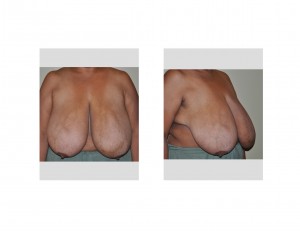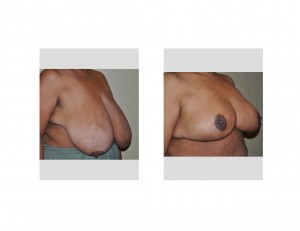Background: A large breast size is well known to put a strain on back, shoulder, and neck muscles. The constant pulling of the breast weight across the shoulders strains the entire upper body. This is magnified when the large breast also have a large amount of ptosis or sagging, as most large breasts do particularly in older women. In some cases of large breasts, their weight has been shown to affect lung expansion with lower recorded oxygen saturations due to underventilation.
The basis of a breast reduction procedure is a combined breast tissue removal with a major lift and nipple relocation. The outside marks or operative design that many patients see is the lift part of the procedure and includes skin removal, the pattern of breast skin tightening, and an areolar reduction. The actual removal of breast tissue is not outwardly obvious because there are no marks done on the skin to indicate it. The removal is a reduction in the size of the mound of breast tissue keeping the nipple attached to it and being careful not to undercut its blood supply.
Breast reduction can physiologically be done at any age. There are risks of going under anesthesia for an operation that can take two to four hours to complete and the patient’s medical history must be considered. But from a tissue healing standpoint, a woman’s age does not affect it. Thus, it is never too late to get the health benefits of what a breast reduction can achieve.



There is no reason that breast reduction surgery can not be done on someone in their 60s or even older. Despite the magnitude of the procedure in terms of breast tissue trauma and reshaping, wound healing will occur as well as in someone much younger. More importantly, the improvement in musculoskeletal pain may mean more to an older patient who may already have other joint and muscle pains.
Case Highlights:
1) Breast reduction can have a dramatic impact on reduction of musculoskeletal pain from large breasts.
2) Very large breasts can be safely reduced with an inferior pedicle technique without free nipple grafting.
3) Even in older women, it is never too late to acquire the health benefits of breast reduction.
Dr. Barry Eppley
Indianapolis, Indiana


